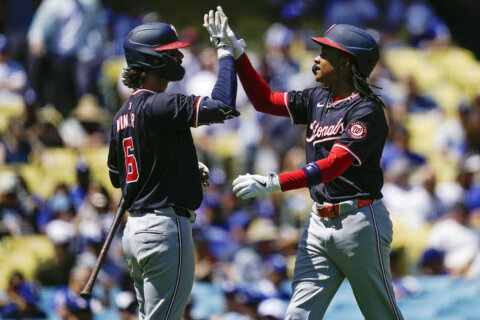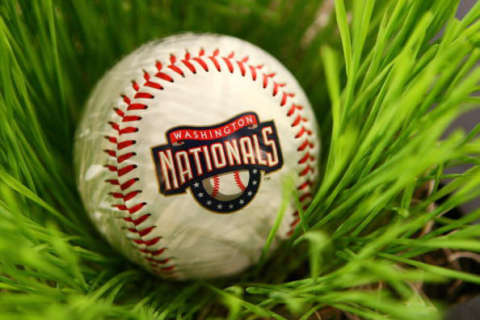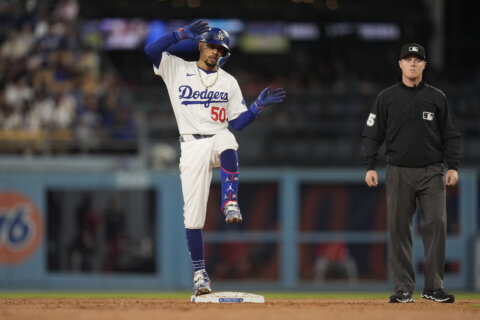Acquiring Josh Bell gives Nationals room to spend for a power bat originally appeared on NBC Sports Washington
Josh Bell is in. What now?
Bell’s projected arbitration figure is around $6 million following his Thursday trade from the Pirates to the Nationals. Last year, the Nationals entered 2020 with Ryan Zimmerman and Eric Thames set to platoon for around $5 million. So, they obtained what translates to cheap power at first base which can be supplemented with a right-handed partner for around the same cost as their previous platoon.
Which moves Mike Rizzo onto what’s next. Trading for Bell did not require top prospects or a large amount of cash. The 28-year-old is right within the first base budget lines. Bringing him in eliminated the dual need of a full-time first baseman and additional home runs in the lineup. Remaining is the hunt for more power and the “middle-of-the-order” bat Rizzo said was the offseason’s top priority.
Related: Bell acquisition doesn’t close the door on Zimmerman’s return
When Rizzo mentioned the phrase, he followed it by saying the lineup boost could come from first base or corner outfield. The first is resolved and allows room for a large expenditure for the next.
The following exercise comes with the standard caveats: it’s a projection of one path the Nationals could go down now. This offseason is exceedingly difficult to predict because of last year’s revenue issues and the lack of full clarity in regard to the 2021 season. With all that said, here’s where the Nationals could go:
At third base, they could pay a veteran similar to Bell. Jake Lamb and Travis Shaw fit in that sense. Both are left-handed, which would help down the lineup where Yan Gomes and Victor Robles will be hitting right-handed. Shaw had a poor 2019 and a mediocre 2020, which led to him being non-tendered by Toronto. He’s 30 years old, had strong seasons in 2017 (.862 OPS) and 2018 (.825). Lamb is also 30 and has been grappling with injuries since potent years in 2016 (.840 OPS) and 207 (.844 OPS) for Arizona. Paying either of them would essentially be a play for more cheap power. They would also send Carter Kieboom back to Triple-A. If Shaw or Lamb flounders, Kieboom could come up.
Download and subscribe to the Nationals Talk Podcast
The big play could come in left field. This is where Michael Brantley could show up.
If the team has Bell and Shaw/Lamb for pop, it would have Brantley for his premier contact rate. Brantley has a career contact rate of 90.9 percent. He swings at pitches outside the strike zone just 24.9 percent of the time. For his career, Brantley makes contact an absurd 96 percent of the time when he swings at pitches inside the strike zone. He would be the National’s high-cost free agent, possibly on a three- or four-year deal.
Josh Harrison is already signed to be the utility infielder. The fourth outfielder is Andrew Stevenson. And, finally, the backup catcher would be another low-cost free agent.
This ensemble could produce a lineup that looks like this:
Trea Turner, SSJuan Soto RF (L)Starlin Castro, 2BMichael Brantley, LF (L)Josh Bell, 1B (S)Travis Shaw/Jake Lamb, 3B (L)Yan Gomes, CVictor Robles, CF
Bench: Stevenson, Harrison, backup first baseman, backup catcher
Yes, Castro hitting third. If Soto hits second, Martinez will want a right-handed hitter behind him — ideally. Bell will mostly hit left-handed. He’s much better from that side. There’s a point where stacking a lineup lefty-left matters little because the hitters are so good. Recall when Bryce Harper and Daniel Murphy hit back-to-back. Avoiding that tactic is debatable in this case. Bell is decidedly worse against left-handed pitching. The aforementioned first base partner with Bell will presumably be right-handed. So, if a team went to a left-handed pitcher for the Brantley-Bell- third base portion, it would be countered by that bat off the bench.
However, most opponents will be starting a right-handed pitcher, which would inject Bell into the third spot in front of Brantley and line up three tough left-handed bats. Castro could backtrack to fifth. Or even sixth in that scenario.
The primary purpose of this exercise is less about where Castro hits and more about how the Nationals are now in a good spot to spend money on one assured big bat. Then they can add a what-if veteran to the fold, creating further lineup depth and helping them rise from one of the worst home run hitting teams in the league. The trade for Bell created all this opportunity.







